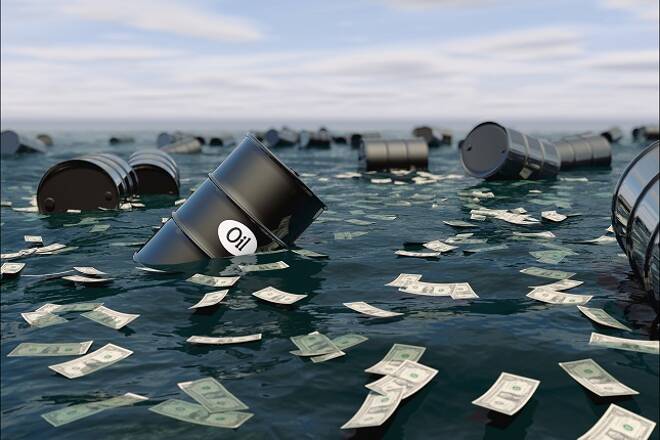Advertisement
Advertisement
Oil Price Fundamental Daily Forecast – Bearish Factors Piling Up
By:
Moving forward, we have to consider several factors. Firstly, if the new list of tariffs on China are eventually imposed then China could turnaround and tax U.S. oil. Secondly, the recent rally was being supported partly from a drop in Libyan output. If Libyan production can get back to its high then this will take care of some of the spare capacity concerns. Thirdly, the new unknown is how much oil will the possible relaxation of U.S. sanctions on Iranian crude exports bring into the markets? Finally, we have to continue to expect production from Saudi Arabia, Russia and the U.S. to rise.
U.S. West Texas Intermediate and international-benchmark Brent crude oil futures plunged on Wednesday on worries that escalating trade tensions between the United States and China could hurt oil demand, and news that Libya would reopen its ports raised expectations of growing supply.
On Wednesday, September WTI crude oil futures settled at $68.86, down $3.70 or -5.37% and September Brent crude oil futures finished the session at $73.40, down $5.46 or -7.44%.
On Thursday at 1106 GMT, September WTI crude oil is trading $69.46, up $0.60 or +0.87% and September Brent crude oil is at $74.21, up $0.81 or +1.10%. Most of the price action is being fueled by profit-taking and short-covering as yesterday’s steep sell-off may have been overdone.
Wednesday’s Recap
The markets were under pressure before the regular session opening on Wednesday in reaction to the release of a new list of tariffs on China by the United States. This raised the possibility that China would retaliate by slapping a tariff on imports of U.S. crude oil. This action would substantially weaken demand for U.S. WTI crude oil.
Prices were further pressured after U.S. Secretary of State Mike Pompeo said on Tuesday that Washington would consider requests from some countries to be exempt from sanctions due to go into effect in November to prevent Iran from exporting oil.
Washington had previously said countries must halt all imports of Iranian oil from November 4 or face U.S. financial restrictions, with no exemptions. So the Pompeo announcement came as a surprise for those holding long futures contracts.
The first two events set the table for the steep sell-off, which was triggered after Tripoli-based Libya National Corp. said four export terminals were being reopened after eastern factions handed over the ports, ending a standoff that had shut down most of Libya’s oil output.
In other news, the U.S. Energy Information Administration said on Wednesday that U.S. crude stockpiles fell by 12.6 million barrels during the week-ending July 6. This was the biggest price slide in nearly two years.
Additionally, a report showed Saudi Arabia hiked its oil output in June to the highest level since the end of 2016, as it aims to cool the market after crude prices recently rose to 3-1/2-year highs.
Forecast
Moving forward, we have to consider several factors. Firstly, if the new list of tariffs on China are eventually imposed then China could turnaround and tax U.S. oil. This could have an impact on global growth and demand.
Secondly, the recent rally was being supported partly from a drop in Libyan output. Reports show that production fell to 527,000 barrels per day (bpd) from a high of 1.28 million bpd in February following the port closures. If Libyan production can get back to its high then this will take care of some of the spare capacity concerns.
Thirdly, the new unknown is how much oil will the possible relaxation of U.S. sanctions on Iranian crude exports bring into the markets?
Finally, we have to continue to expect production from Saudi Arabia, Russia and the U.S. to rise. Additionally, at some time in the near future, the Canadian pipeline problem will be fixed and the supply disruption over. This will bring additional crude to the market.
According to the September WTI chart, the trend is down according to the daily chart, putting the market in a position to test $67.99 to $66.81. Trader reaction to this zone will tell us if the buying or selling is greater at current price levels.
About the Author
James Hyerczykauthor
James is a Florida-based technical analyst, market researcher, educator and trader with 35+ years of experience. He is an expert in the area of patterns, price and time analysis as it applies to futures, Forex, and stocks.
Did you find this article useful?
Latest news and analysis
Advertisement
